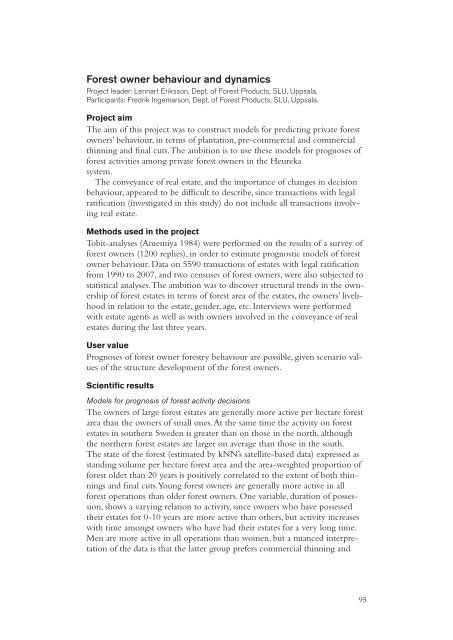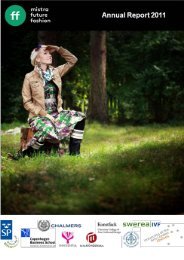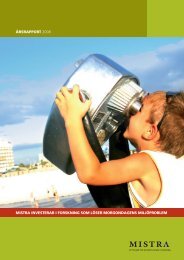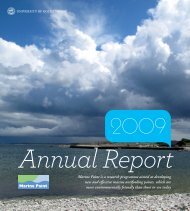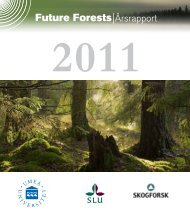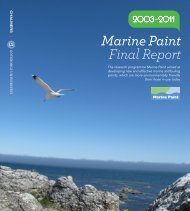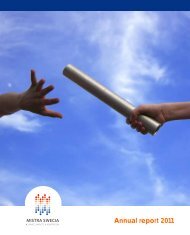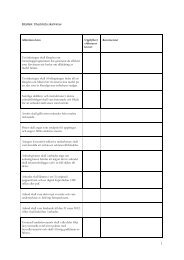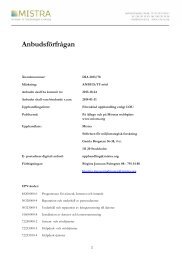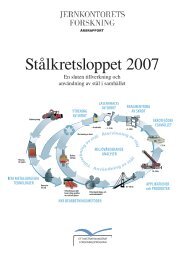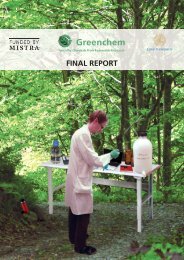ReferencesScientific artiklesHankala, A., Wikström, P., and Eriksson, L.O. 2009. Using Software to support forestrydecision making with multiple goals: a case study with the MCDA application of the<strong>Heureka</strong> planning system. (in Prep).External referencesBelton, Valerie & Stewart, <strong>The</strong>odor J. (2001). Multiple Criteria Decision Analysis: Anintegrated approach. Kluwer Academic Publishers, Dortdrecht, <strong>The</strong> NetherlandsFrench, Simon & Xu, Dong-Ling (2005). Comparison study of multi-attribute decisionanalytic software. J. Multi-Crit. Decis. Anal. 13: 65-80Hörnsten, Lisa (2000). Outdoor Recreation in Swedish Forests – Implications for Societyand Forestry. Doctoral thesis. Swedish University of Agricultural Sciences. UppsalaJankowski, Piotr, Andrienko, Natalia and Andrienko, Gennady (2001). Map-centredexploratory approach to multiple criteria spatial decision making. Int. J. GeographicalInformation Science 15 (2): 101-127Kangas, Annika, Kangas, Jyrki & Kurttila, Mikko (2008). Decision support for forestmanagement. [Dordrecht]: SpringerKangas, Jyrki & Kangas, Annika (2005). Multiple criteria secision support in forest management– the approach, methods applied, and experiences gained. Forest Ecology andManagement 207: 133-143Kangas, Jyrki, Kangas, Annika, Leskinen, Pekka and Pykäläinen, Jouni (2001). MCDMMethods in strategic planning of forestry on state-owned lands in Finland: Applicationsand experiences. J. Multi-Crit. Decis. Anal. 10: 257-271Mendoza, G. A. and Martins, H. (2006). Multi-criteria decision analysis in naturalresource management: A critical review of methods and new modeling paradigms. ForestEcology and Management 230: 1-22Sheppard, Stephen R.J. and Meitner, Michael (2005).Using multi-criteria analysis andvisualisation for sustainable forest management planning with stakeholder groups. ForestEcology and Management 207: 171–187Wolfslehner, Bernhard, Vacik, Harald and Lexer, Manfred J. (2005) Application of theanalytic network process in multi-criteria analysis of sustainable forest management. ForestEcology and Management 207: 157–17094
Forest owner behaviour and dynamicsProject leader: Lennart Eriksson, Dept. of Forest Products, SLU, Uppsala.Participants: Fredrik Ingemarson, Dept. of Forest Products, SLU, Uppsala.Project aim<strong>The</strong> aim of this project was to construct models for predicting private forestowners’ behaviour, in terms of plantation, pre-commercial and commercialthinning and final cuts. <strong>The</strong> ambition is to use these models for prognoses offorest activities among private forest owners in the <strong>Heureka</strong>system.<strong>The</strong> conveyance of real estate, and the importance of changes in decisionbehaviour, appeared to be difficult to describe, since transactions with legalratification (investigated in this study) do not include all transactions involvingreal estate.Methods used in the projectTobit-analyses (Amemiya 1984) were performed on the results of a survey offorest owners (1200 replies), in order to estimate prognostic models of forestowner behaviour. Data on 5590 transactions of estates with legal ratificationfrom 1990 to 2007, and two censuses of forest owners, were also subjected tostatistical analyses. <strong>The</strong> ambition was to discover structural trends in the ownershipof forest estates in terms of forest area of the estates, the owners’ livelihoodin relation to the estate, gender, age, etc. Interviews were performedwith estate agents as well as with owners involved in the conveyance of realestates during the last three years.User valuePrognoses of forest owner forestry behaviour are possible, given scenario valuesof the structure development of the forest owners.Scientific resultsModels for prognosis of forest activity decisions<strong>The</strong> owners of large forest estates are generally more active per hectare forestarea than the owners of small ones. At the same time the activity on forestestates in southern Sweden is greater than on those in the north, althoughthe northern forest estates are larger on average than those in the south.<strong>The</strong> state of the forest (estimated by kNN’s satellite-based data) expressed asstanding volume per hectare forest area and the area-weighted proportion offorest older than 20 years is positively correlated to the extent of both thinningsand final cuts. Young forest owners are generally more active in allforest operations than older forest owners. One variable, duration of possession,shows a varying relation to activity, since owners who have possessedtheir estates for 0-10 years are more active than others, but activity increaseswith time amongst owners who have had their estates for a very long time.Men are more active in all operations than women, but a nuanced interpretationof the data is that the latter group prefers commercial thinning and95
- Page 3:
ContentsResearch Programme 5Applica
- Page 7 and 8:
Growth and yieldmodelsSP1 Forest Ec
- Page 9 and 10:
forest production, and social value
- Page 11 and 12:
Applications of the Heureka systemT
- Page 13 and 14:
data, improving opportunities to in
- Page 15 and 16:
User valueA complete decision suppo
- Page 17 and 18:
opment scenarios for a stand that w
- Page 19 and 20:
Programme meeting including an excu
- Page 21 and 22:
forest roads, 10 time periods, four
- Page 23 and 24:
Figure 6. Examples of screen layout
- Page 25 and 26:
Implementations in practical forest
- Page 27 and 28:
Thematic research projectsGrowth an
- Page 29 and 30:
600PineSpruceBirch500400Max-age, yr
- Page 31 and 32:
Specification of silviculturaland n
- Page 33 and 34:
zones and other tree groups. Border
- Page 35 and 36:
expresses the expected potential in
- Page 37 and 38:
tions, mainly using current forest
- Page 39 and 40:
ReferencesPopular science publicati
- Page 41 and 42:
identified relationships were used
- Page 43 and 44: Fulfilment of objectivesThe goal of
- Page 45 and 46: Soil biogeochemical modellingProjec
- Page 47 and 48: Scientific resultsSoil carbon model
- Page 49 and 50: model (Fig. 18). In addition, the w
- Page 51 and 52: Hodson, M.E., Langan, S.J. & Wilson
- Page 53 and 54: phytes, fungi, lichens, invertebrat
- Page 55 and 56: forest net value revenues and the p
- Page 57 and 58: Wood propertiesProject leader: Lars
- Page 59 and 60: pulpwood energy wood sections) are
- Page 61 and 62: Table 1. Properties that can be pre
- Page 63 and 64: Hannrup, B. et al. (manuscript). Mo
- Page 65 and 66: value model, based on both stand at
- Page 67 and 68: uscript in prep.Working papersLindh
- Page 69 and 70: een tested.Estimates of forest para
- Page 71 and 72: Conference proceedingsNilsson, M.,
- Page 73 and 74: Selection of plot data to represent
- Page 75 and 76: set, in the BIOMASS and IRIS projec
- Page 77 and 78: the end of the project period. The
- Page 79 and 80: y a study of the consequences for H
- Page 81 and 82: Field trials in the project Data ac
- Page 83 and 84: Fulfillment of objectivesThe main e
- Page 85 and 86: vests? As a result, for the identif
- Page 87 and 88: Figure 26. The spatial layout of ha
- Page 89 and 90: Multi-Criteria Decision AnalysisPro
- Page 91 and 92: !"#$%&'N)';%&4&32-2",3',6'5-2-'6,%'
- Page 93: problems. Spatial problems pose par
- Page 97 and 98: area between these size groups has
- Page 99 and 100: Programme managementWhen the second
- Page 101 and 102: Funding and expenditureFundingThe s
- Page 103 and 104: Publications in phase I and phase I
- Page 105 and 106: Freeman, M., Severinsson, T., Moré
- Page 107 and 108: Pettersson, H. & Ståhl, G. 2006. F
- Page 109 and 110: forests at the landscape level. MSc
- Page 111 and 112: Lanvin, J-D. Bajric, F. Wilhelmsson
- Page 113 and 114: ceedings from the 24th EARSeL Sympo
- Page 115 and 116: ceedings 3rd Forest Engineering Con
- Page 117 and 118: Lämås, T., Ståhl, G. och Dahlin,
- Page 119: Anon., 2005. The Heureka Research P


